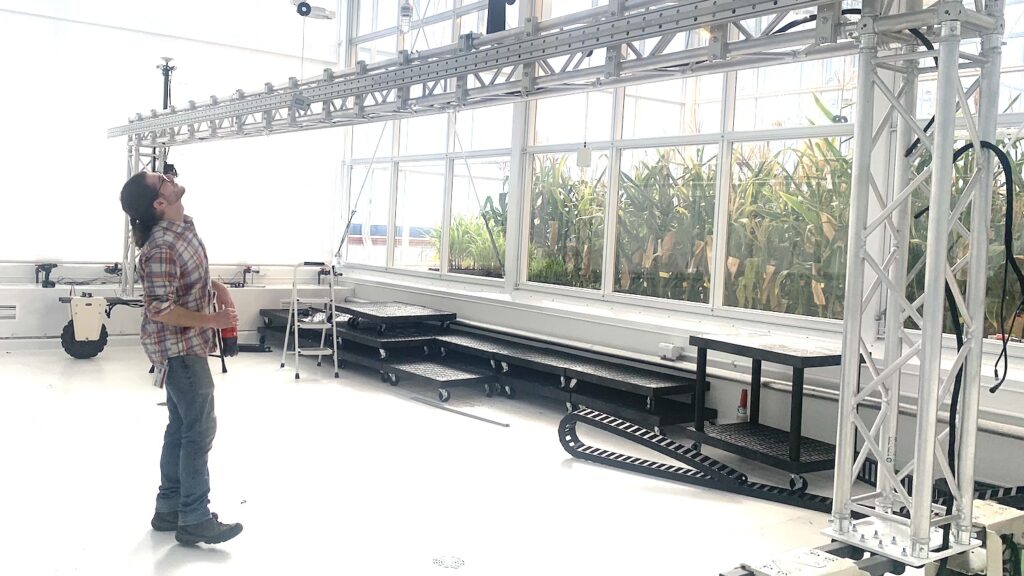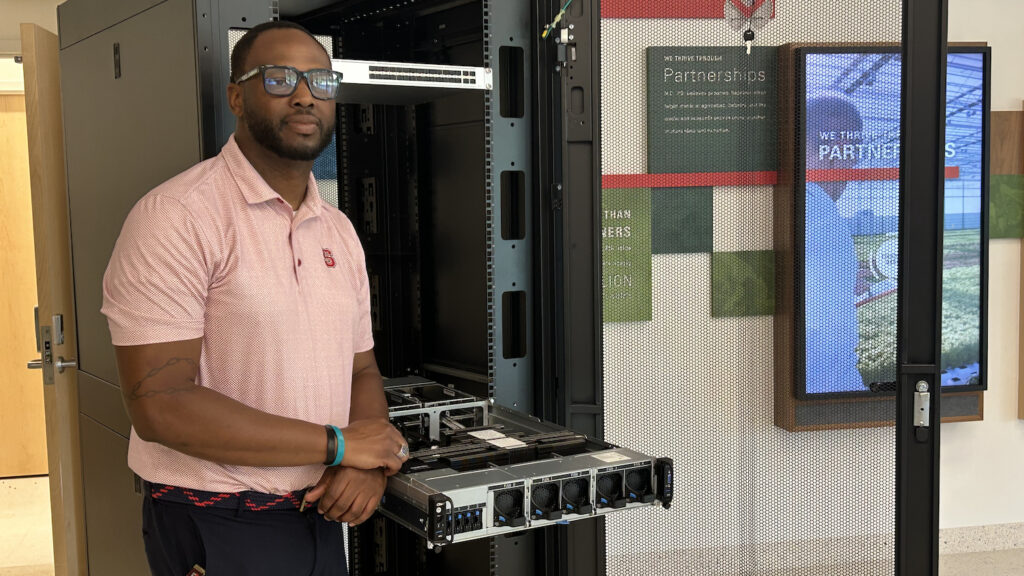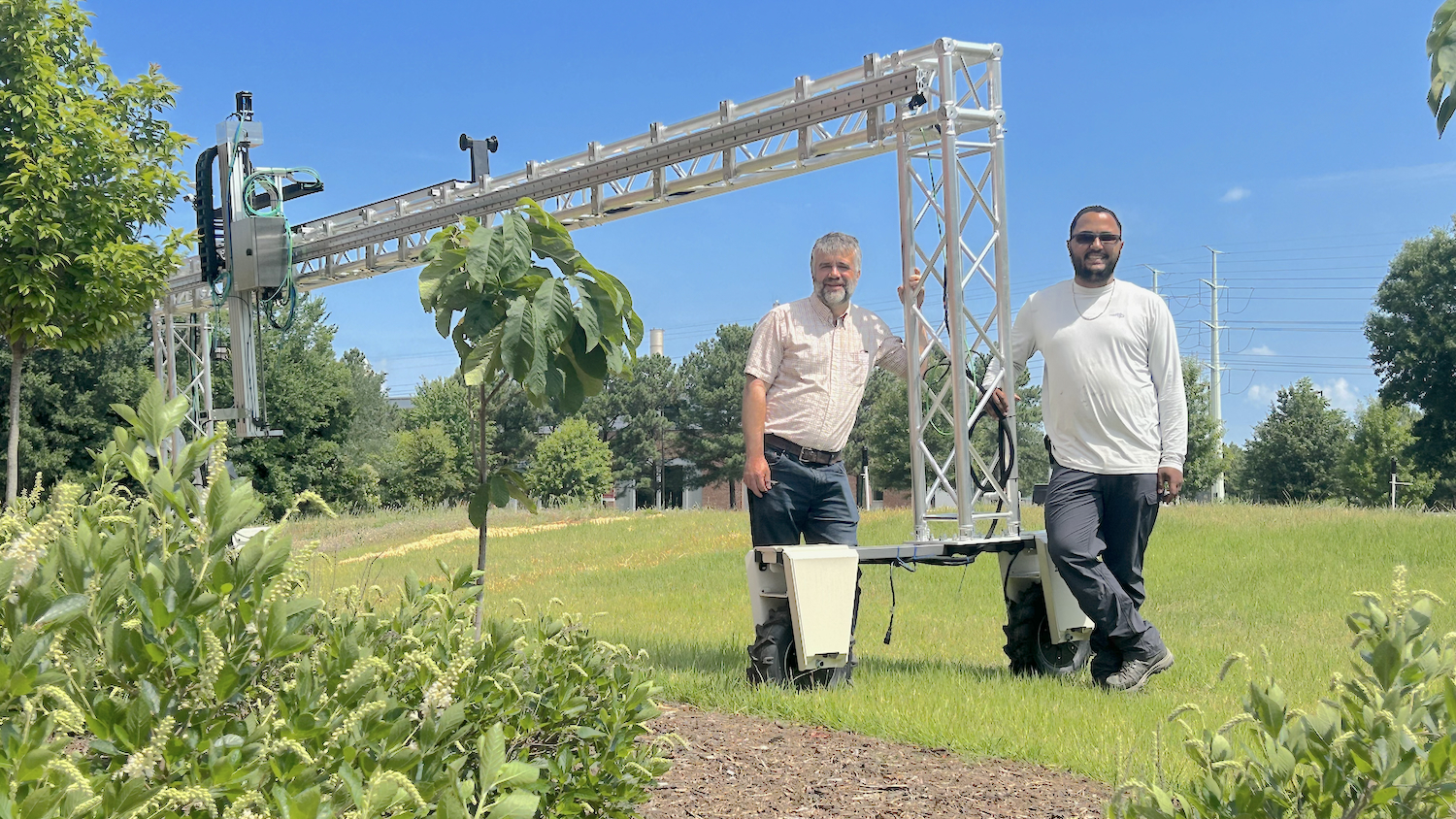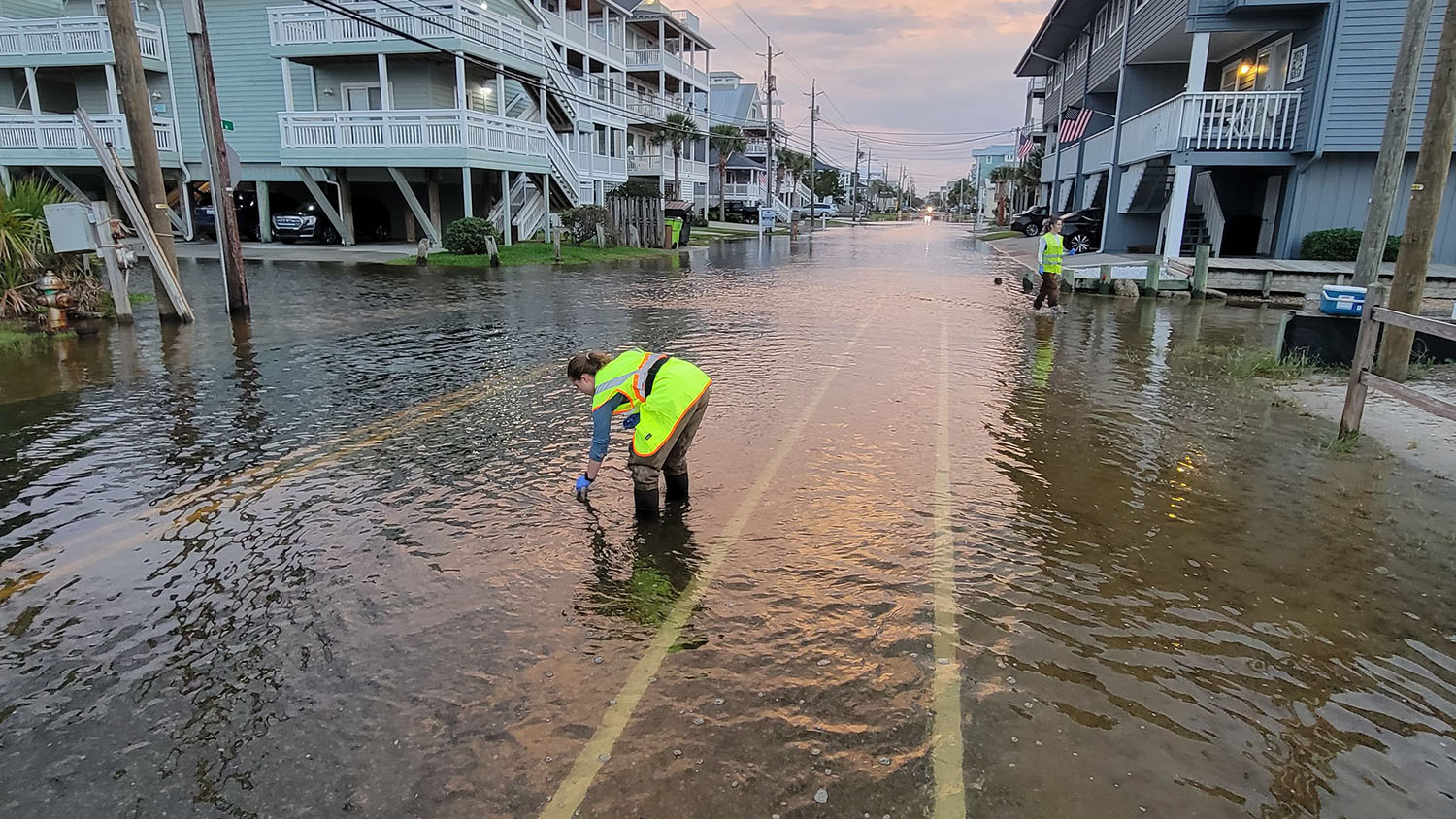At NC State University, the N.C. Plant Sciences Initiative is leading efforts aimed at helping producers put artificial intelligence to work for increased yields, efficiency and sustainability.
Two new tools will propel its work in AI for agriculture forward: A robot named BenchBot 3.0 has taken its place on an empty field adjacent to the Plant Sciences Building on NC State’s Centennial Campus. It’s just one of the data-gathering devices that will be tied into the power of N.C. PSI’s newly acquired supercomputer, the NVIDIA Grace Hopper 200, to create AI for agricultural applications.
One of the Grace Hopper’s first tasks will be to begin making sense of the half million plant photos that BenchBot will take as it passes repeatedly over 500 pots of different plant species.
The Grace Hopper … gives us the capability to train even larger-scale models to become more accurate and more predictive in nature and come up with solutions to more complicated challenges.
Those photos, along with ones taken by earlier versions of the BenchBot, will help feed what N.C. PSI Platform Director for Resilient Agriculture Chris Reberg-Horton says will be the world’s largest open-source agricultural image repository.
Reberg-Horton and his colleagues in the Precision Sustainable Agriculture network will use the collected photos to develop software and tools that can help farmers make all kinds of decisions about their crops: when and where to harvest, spray for weeds or insects, fertilize and more.
Getting from photos to those applications will take powerful AI, and the NVIDIA Grace Hopper, with its ability to handle five terabytes of data per second, is just the right tool, says Jevon Smith, N.C. PSI’s research computing manager.
The most powerful computer of its kind on NC State’s campus, the machine enables teams working on interdisciplinary plant sciences research to take on large datasets, like the image repository, to make more complex models and come up with solutions faster than ever.
Step One: Telling Apples From Oranges
Getting computers to recognize plants, weeds and other stressors is the first step toward getting machines to detect problems or map performance, says Reberg-Horton, the Blue Cross and Blue Shield of North Carolina Foundation/W.K. Kellogg Distinguished Professor in Sustainable Community-Based Food Systems in the Department of Crop and Soil Sciences.
He likens what he and his colleagues are doing to build the image repository and create grower decision tools to what car companies have done to make self-driving cars a reality.
In a lot of economic sectors, we have literally millions of images labeled so that we can train computers on tasks like driving around a city. We don’t have that in agriculture.
“If you’ve got a company that is trying out some new technology for self-driving cars, the first thing they have got to do is to train computers to understand and recognize the things a car sees, and so if you’ve ever done the CAPTCHA stuff — identify the bicycles, identify the pedestrians — you’re basically helping train AI because you’re labeling images so that computers can learn to recognize, ‘That’s a person. Don’t hit the gas now,’” he says.
And it’s not just self-driving cars that use such image-based AI.
“In a lot of economic sectors, we have literally millions of images labeled so that we can train computers on tasks like driving around a city,” he says. “We don’t have that in agriculture.”

The agricultural image repository is designed to help technology developers fill that gap. Ag technology companies large and small will have access, as will anyone who uses the internet.
Already, with earlier versions of the BenchBot, Reberg-Horton says the team “has tackled about 30 of the most common weed species in North America. For cash crops, we have imaged corn, soybeans, cotton, wheat, rye, barley and oats.”
“In theory we can do about 1,000 plant pots per day, but we will test logistics slowly before going that big,” Reberg-Horton adds. “This summer will be just weeds. From October to March, we will image winter cover crop species.”
Meanwhile, two other BenchBots are being deployed to add images from different locations. One is at the U.S. Department of Agriculture’s Agricultural Research Center in Beltsville, Maryland, while a third will be deployed soon at College Station, home of Texas A&M University.
Achieving Precision Agriculture’s Promises
The images the BenchBots collect will help overcome a bottleneck in fully realizing the concept of precision farming, Reberg-Horton notes.
In precision farming, producers deliver exactly what a plant needs, precisely when and where and in what amounts it’s needed. For example, rather than spraying an entire field for insects, which would be expensive, they could spray just the areas where they are a problem. That would protect crops, limit chemical use and safeguard the environment from excess application.
Applications in the agriculture sector include increasing yields, reducing waste, helping reduce carbon emissions, and more.
Thanks to information technology, the concept of precision farming, forged in the 1980s, has taken off since the 2000s.
Smith says that while AI has become controversial, its rapid development is pushing precision farming technology ahead faster than ever.
“You can’t turn on the TV without hearing two letters — AI,” Smith says. “There are so many bad stories about AI out there, but the applications in the agriculture sector include increasing yields, reducing waste, helping reduce carbon emissions, and more. It can be used for great good.”
And it already is.
There are self-driving tractors and combines, and some are equipped with variable rate equipment that can sense where to apply chemicals and where to plant seeds — and do those tasks. Artificial intelligence is also used in farming for water management, crop rotation, harvest timing, optimal planting and more.
“We’ve been talking about precision agriculture for decades,” Reberg-Horton says. “It’s really been aspirational for the most part because we have to have lots of knowledge about a field to be able to manage each piece of the field optimally. The smart equipment is available now to apply most of our inputs variably. But we have been stuck on creating enough intelligence to tell that equipment what to do.
“Computer vision is the technology that can do it, and we will start seeing cameras on all of our agricultural machinery.”
What’s Happening With AI at the N.C. PSI
The N.C. PSI has made significant headway in applying AI in agriculture. For example, to allow growers to know precisely when to plant soybeans and how to manage soybeans in counties across the state, Rachel Vann — has worked alongside computer engineering experts to lead a team developing an AI-powered web application that will be released this fall. Vann is an NC State Extension soybean specialist, assistant professor in the Department of crop and Soil Sciences and N.C. PSI platform director for extension outreach and engagement.
Her colleague, Cranos Williams — N.C. PSI’s platform director for data analytics and Goodnight Distinguished Professor of Agricultural Analytics in the Department of Electrical and Computer Engineering — is among the leaders of N.C. PSI’s Sweet-APPS team. The team is working to reduce labor in the post-harvest handling of sweetpotatoes by helping producers use sensors and machines to sort and grade the vegetables by size, shape and other characteristics.
And to increase soybean resilience to climate change, N.C. PSI’s Ross Sozzani, professor in the Department of Plant and Microbial Biology and platform director for plant improvement, is working with U.S. Department of Agriculture scientist Anna Locke, as well as colleagues at the VIB, a life sciences institute in Belgium. The team is marrying machine learning, crop physiology and phosphoproteomics to evaluate the plant’s temperature stress regulators and develop a test to rapidly screen soybean genetics for temperature tolerance. The data they generate will allow the breeders to identify temperature-tolerant soybean varieties more efficiently.
More Tools From Reberg-Horton
Meanwhile, crop scientist Reberg-Horton is making progress with several AI-powered tools, some that rely on images in the repository he’s helping build. One tool uses cameras and AI-trained software to allow growers to map where they have herbicide-resistant weeds, such as the notoriously noxious palmer amaranth.
He calls the weed “sticky” because it tends to come back to the same area where it’s grown the previous year. Having a map of where palmer amaranth grew one year would help the farmer know where to use pesticides or rotate crops in the following year.
“It may sound trivial, but you’ve got to remember that the farmers that I deal with — big row crop farmers — might have 5,000 acres spread over multiple counties,” he says. “Given the growth that’s occurred in the size of farms, thinking they know where everything is at and where the bad spots are is just not true anymore.”
We’ve been talking about precision agriculture for decades. … The AI revolution has been a missing piece.
Another tool Reberg-Horton’s working on is designed for those who grow cover crops, which are planted in the off-season on land where cash crops are grown. They help manage soil quality, fertility, erosion and pests such as weeds and insects. Because cover crops have environmental benefits, the federal government offers incentives for planting them.
“Increasingly the Natural Resources Conservation Service is encouraging mixtures of species. So you might have a legume and a grass in a mix. Sometimes we even see complicated mixes where you might have five or six species,” he says.
“Applying the right amount of the fertilizer nitrogen onto crops like corn is already tricky because soils are not uniform across a field,” he explains. “Cover crop mixtures can amplify that variation because legumes in the mix will supply nitrogen to the corn, while other cover crops in the mix will not. We have to map the growth of each species to account for that. In essence, we are asking AI to recognize plant species.”
Using that information to reduce the need for nitrogen fertilizer saves money for farmers and reduces the environmental impact: Nitrates are lead contaminants of groundwater, where they can cause drinking water problems, and can run into surface water, where they can cause algal blooms.
Putting More Power in the Interdisciplinary Mix
In supporting the development of smart tools for agriculture, the Grace Hopper will give the N.C. PSI an advantage. The computer is named for a computer programming pioneer who began her U.S. Navy career during World War II.
To secure and deploy the Grace Hopper, N.C. PSI has partnered with Cambridge Computing, an NVIDIA reseller that specializes in consulting with universities and research institutions. N.C. PSI secured one of 50 university seed grants to get the supercomputer.

“We already have two machine learning systems, and the Grace Hopper is a new tool on a level we haven’t had before,” Smith says. “It gives us the capability to train even larger-scale models to become more accurate and more predictive in nature and come up with solutions to more complicated challenges.”
One of the top challenges has meaning for farmers and consumers alike. “Growers are faced with needing to meet a growing population’s need for more food at the same time that climate change is altering growing conditions,” Smith says.
U.S. farmers are also facing serious labor shortages. While one of the fears surrounding AI is that it’ll take away jobs, supporters say it may hold promise for easing agricultural worker shortages, especially with the labor-intensive crops that North Carolina is known for — sweetpotatoes and tobacco, for starters.
As Reberg-Horton notes, “We’ve been talking about precision agriculture for decades. We know what we want, but it’s hard to get there. The AI revolution has been a missing piece that’ll help us get there.”
This post was originally published in Plant Sciences Initiative.



